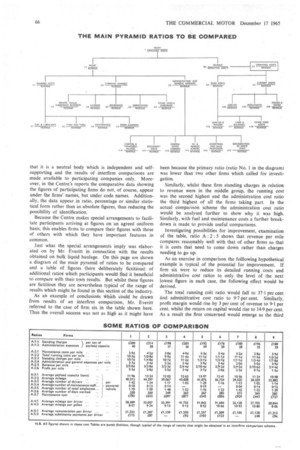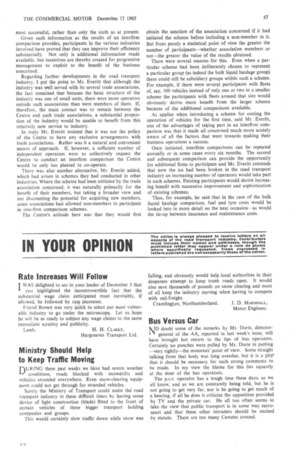Interfirm Comparison the next step
Page 67

Page 68

Page 69

If you've noticed an error in this article please click here to report it so we can fix it.
The recent exercise on bulk liquid haulage costing by the Centre for Interfirm Comparison could be a pointer to greater efficiency in road transport operation COMMENT was made in this series on November 26 as to the value to be derived from putting costing to wider use. Whilst the very process of setting up a system of costing the operation of a fleet of commercial vehicles could, of itself, induce greater efficiency within the business, the ultimate results are the prime objectives of costing.
Even then, there remains the need for management to put the information obtained from such costing to positive use. A road transport operator will most readily do this within his own organization by a comparison of past and present performance or, more precisely, the comparison of the immediate past with previous experience. But such records do no more than justify, if that, past expenditure on what is by now " historic " operation.
However, when immediate past records are used to provide as sound a basis as is currently available on which to estimate the trend of future costs and to indicate opportunities for economies, the true worth of costing is then being realized.
Many successful operators have built up sound businesses by just such a procedure, coupled, of course, with other qualities of management. In the process of continual striving for greater efficiency there can be no finality, but as experience grows within one organization the opportunities for improvement diminish—or at least appear to— with each successive improvement achieved.
LIMITED COMPARISONS
Such a contention is, however, valid only whilst all comparisons are limited to experience within one organization. In recent years there have been continuing examples of mergers and amalgamations, including those within road transport itself. Quite apart from direct economies of scale which are substantial, the new opportunities and greater scope for cost comparison between the companies involved in a merger are of very real and positive value.
In reverse of the contention that an army progresses as fast as its slowest unit, the aim of a new merger is obviously to up-grade the efficiencies of its several component parts to the optimum already achieved by its most efficient unit—or better.
Despite the very marked trend towards mergers and amalgamations which make just such an exercise possible, there are—and presumably will remain—a large _number of relatively small or medium-sized road transport operators who will continue at around their present size for at least the immediate future. Nevertheless, they would benefit substantially from an opportunity to have access to comparable costings outside their own business.
It was to meet precisely this purpose that the Centre for Interfirm Comparison Ltd., 80 Fetter Lane, London EC4, was set up in 1959 by the British Institute of Management in association with the British Productivity Council to conduct interfirm comparisons on a confidential basis as a service to management. The Centre has been established as a separate company so that• the service it provides should not be confined to members of its sponsoring organizations but should be widely available to industry and trade. It depends for its income on fees charged for its services, but because it is a non-profitmaking organization its charges are based on actual costs.
EXPERIENCE OF 30 INDUSTRIES
The Centre has now had experience of interfirm comparison in more than 30 industries, including bulk liquid road haulage and C-licence operation. The normal procedure is for the Centre to contact the relevant trade association and invite its assistance or, alternatively, to make direct approaches to firms in a particular industry. Fees naturally vary according to the amount of work required; as an example, a straightforward scheme might cost in the region of 75 gns. per firm. But this could rise to 200 gns. for more detailed schemes, including visits to the firms concerned.
Reports have been carried in The Commercial Motor as news items of proposals for the employment of the Centre for Interfirm Comparison when they have arisen in the road transport industry, primarily in connection with the National Association of Furniture Warehousemen and Removers, the Traders Road Transport Association and the bulk liquid group of the Road Haulage Association.
Whilst the proposals in the first two cases are still being investigated, the preliminary tabulation of results of the interfirm comparison on bulk liquid haulage has now been issued. Accordingly it is opportune to reassess what just such an interfirm comparison involves and the benefits to be derived by the participants.
With this object in mind I discussed last week with Mr. W. J. Haydn Everitt, of the Centre for Interfirm Comparison, the implications of the results obtained on bulk liquid haulage and the possibility of further exercises in interfirm comparison in the road transport industry.
Because road transport is a highly competitive industry there is an understandable reluctance on the part of individual operators to disclose vital information and statistics as to the profitability—or otherwise—of their businesses.
A key factor in the success of the Centre is the fact that it is a neutral body which is independent and selfsupporting and the results of interfirm comparisons are made available to participating companies only. Moreover, in the Centre's reports the comparative data showing the figures of participating firms do not, of course, appear under the firms' names, but under code names. Additionally, the data appear in ratio, percentage or similar statistical form rather than as absolute figures, thus reducing the possibility of identification.
Because the Centre makes special arrangements to facilitate participants arriving at figures on an agreed uniform basis, this enables firms to compare their figures with those of others with which they have important features in common.
Just what the special arrangements imply was elaborated on by Mr. Everitt in connection with the results obtained on bulk liquid haulage. On this page are shown a diagram of the main pyramid of ratios to be compared and a table of figures (here deliberately fictitious) of additional ratios which participants would find it beneficial to compare with their oyvn results. But whilst these figures are fictitious they are nevertheless typical of the range of results which might be found in this section of the industry.
As aft example of conclusions Which could be drawn from results of an interfirrd comparisbn, Mr. Everitt referred to the case of firm six in the table shown here. Thus the overall success was not as high as it Might have been because the primary ratio (ratio No. 1 in the diagram) was lower than two other firms which called for investigation.
Similarly, whilst these firm standing charges in relation to revenue were in the middle group, the running cost was the second highest and the administration cost ratio the third highest of all the firms taking part. In the actual comparison scheme the administration cost ratio would be analysed further to show why it was high. Similarly, with fuel and maintenance costs a further breakdown is made to provide useful comparisons.
Investigating possibilities for improvement, examination of the table, ratio A : 2 : 5 shows that revenue per mile compares reasonably well with that of other firms so that it is costs that need to come down rather than charges needing to go up.
As an exercise in comparison the folllowing hypothetical example is typical of the potential for improvement. If firm six were to reduce its detailed running costs and administrative cost ratios to only the level of the next lowest figure in each case, the following effect would be derived.
The total running cost ratio would fall to 37.1 per cent and administrative cost ratio to 9-7 per cent. Similarly, profit margin would rise by 3 per cent of revenue to 9.1 per cent, whilst the return on capital would rise to 14-9 per cent. As a result the firm concerned would emerge as the third most successful, rather than only the sixth as at present. Given such information as the results of an interfirm comparison provides, participants in the various industries involved have proved that they can improve their efficiency substantially. Not only is additional information made available, but incentives are thereby created for progressive management to exploit to the benefit of the business concerned. Regarding further developments in the road transport industry, I put the point to Mr. Everitt that although the industry was well served with its several trade associations, the fact remained that because the basic structure of the industry was one of small units, there were more operators outside such associations than were members of them. If, therefore, the main contact was to remain between the Centre and such trade associations, a substantial proportion of the industry would be unable to benefit from this relatively new service to industry. In reply Mr. Everitt insisted that it was not the policy of the Centre to have any exclusive arrangements with trade associations. Rather was it a natural and convenient means of approach. If, however, a sufficient number of independent operators were to collectively request the Centre to conduct an interfirm comparison the Centre would be only too pleased to co-operate. There was also another alternative. Mr. Everitt added, which had arisen in schemes they had conducted in other industries. Where the scheme had been initiated by the trade association concerned, it was naturally primarily for the benefit of their members, but taking a broader view and not discounting the potential for acquiring new members, some associations had allowed non-members to participate in interfirm comparison schemes. The Centre's attitude here was that they would first obtain the sanction of the association concerned if it had initiated the scheme before including a non-member in it. But from purely a statistical point of view the greater the number of participants—whether association members or not—the greater the value of the results obtained. There were several reasons for this. Even when a particular scheme had been deliberately chosen to represent a particular group (as indeed the bulk liquid haulage group) there could still be subsidiary groups within such a scheme. For example, if there were several participants with fleets of, say, 100 vehicles instead of only one or two in a smaller scheme the participants with fleets around that size would obviously derive more benefit from the larger scheme because of the additional comparisons available. As applies when introducing a scheme for costing the operation of vehicles for the first time, said Mr. Everitt, one of the advantages of taking part in an interfirm comparison was that it made all concerned much more acutely aware of all the factors that went towards making their business operations a success. Once initiated, interfirm comparisons can be repeated annually or in some cases every six months. The second and subsequent comparison can provide the opportunity for additional firms to participate and Mr. Everitt contends that now the ice had been broken in the road transport industry an increasing number of operators would take part in such schemes. Existing participants would derive increasing benefit with successive improvement and sophistication of existing schemes. Thus, for example, he said that in the case of the bulk liquid haulage comparison, fuel and tyre costs would be looked into in more detail on the next occasion—as would the tie-up between insurance and maintenance costs.












































































































